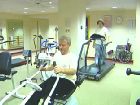
back
Some related articles :
Want
to support Global Action on Aging?
Click
below:

Thanks!
|
 |
I
t's Never Too Late To Get In Shape
By Marjie Mohtashemi,
NY News 1
JANUARY 13, 2003

Otto Mond has collected
dozens of trophies, medals and award certificates from the races he has
run. Not bad for a man who only started when he was 50 years old.
“My son used to go jogging, and he said to me, ‘Come on dad, let's go
together,’” he says.
Now 70, Otto laces up his sneakers at least four times a week for an
average run of five miles. He has also finished more than 30 marathons,
including the past 12 in New York City.
“I find it very exhilarating, particularly when you finish,” says
Otto. “You get a real high.”
Looking at Vivian Lowery, it’s hard to believe she just turned 79. She
walks long distances to stay in shape and has done so in every New York
City marathon since 1981.
“I'm in much better shape than most of my peers, even younger people,”
she says.
Vivian was nearly 60 when she began walking long distances. She has since
trained as a race-walker and finished first in her age group in the 2001
New York City Marathon.
As Otto and Vivian prove, you're never too old to start getting in shape
– and you don't have to run a marathon.
“Walking is always a wonderful exercise, so anyone who can walk without
pain or difficulty can do that,” says Patty Brownstein of the Mt. Sinai
Cardiac Rehabilitation Program. “Bicycling, indoor bicycling, stationery
cycling, is also very good for people with certain problems in their knees
or their hips.”
In addition, swimming and water aerobics are great ways for seniors to get
and stay in shape, Brownstein says. She adds that resistance exercises
with light weights are important for maintaining muscle strength, bone
density and balance. And don't forget to stretch, to maintain or increase
flexibility. And as with any exercise regimen, consult your physician
first.
Most experts recommend at least a half hour of moderate exercise – which
can be broken up into three ten-minute sessions – on most days of the
week.
“Always consider your limitations,” Brownstein says. “So if you have
arthritis or a bad shoulder or something like that, you shouldn't exercise
to a level of pain. It should be comfortable for you to do, and you should
choose something that you feel you will always continually do, because
once you give up the exercise, you lose the benefits of it.”
As seniors are turned on to the benefits of leading a healthy lifestyle,
the New York Road Runners Club says more of them have been participating
in its races in recent years.
“There are now 90-year-olds who are crossing the finish lines in our
marathons, whereas five years ago that wasn't happening,” says Amie
Desautels Fisher of the running organization.
Otto attributes his good health to running and says he has no plans to
slow down. “I hope to run as long as I can,” he says. “There are
other people in my age group and older that run marathons. And as long as
I'm healthy, I hope to continue.”
“It doesn't take any effort,” Vivian of her chosen exercise. “You
don't need any equipment. All you need is your shoes.”
Copyright
© 2002 Global Action on Aging
Terms of Use | Privacy
Policy | Contact Us
|



